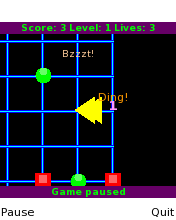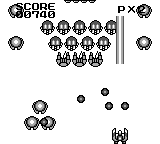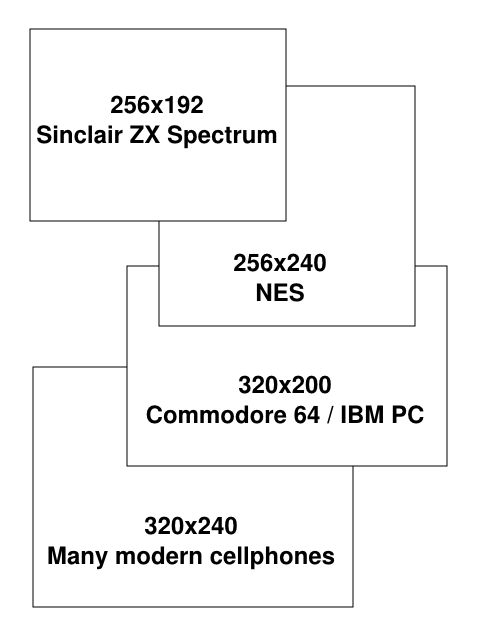What would you consider a decent screen resolution for gaming? 1280×1024? 1600×1200? Or maybe 1920×1080, if you’re a console owner?
My mobile port of Buzz Grid runs just fine on a screen as small as the one on the left:


That’s 176×220, a common resolution for cellphones around 2005. Seems limited? Nintendo Gameboy, possibly the absolute best-selling gaming console ever, had a screen no bigger than the one on the right: only 160×144! And four shades of gray for variety.
Those are extreme examples. But old computers often didn’t have many more pixels to work with. For comparison, I’ve put together this little diagram showing the screen resolution of various classic machines.

Note that these are the actual screen sizes, and the diagram itself is 640×480 pixels large — the same resolution used in Baldur’s Gate II as late as 2001. Many classic games such as Doom and the LucasArts adventures ran in even less — 320×200. My last two cellphones can display them with room to spare.
You could argue that technology marches on, but there is progress and progress. We could have had flying cars and atomic planes decades ago, but we don’t. And you’ll hear all kinds of reasons why, but I say that’s because it would create too many problems for very little gain.
You could also argue that more pixels equals prettier games, and I’ll be the first to admit that Mass Effect (to pick an example) looks spectacular. The problem is, it doesn’t look like a game. More like a movie on DVD that stops now and then to offer you a simplistic choice. Myst, with its blocky 3D renders, moved me a lot more. Speaking of movies, don’t even get me started about the original Star Wars versus newer editions.
Now, if you’re absolutely certain that your next game really, really needs 2 million pixels to look good, by all means, target the absolute latest hardware. But make the decision knowing that the lower limit is 16×16.
Comments
The C64’s resolution was a bit more complicated than that. It was 320×200 in hi-res mode (2 colors per 8×8 square) and 160×200 in multicolor mode (4 colors per 4×8 square, where 2 of those colors are shared across the whole screen without any special tricks), but it was actually possible to extend the screen space into the overscan area giving a higher effective resolution. The equivalent video modes on the IBM PC were 640×200 mono and 320×200 4-color, respectively, although of course the C64 had way more capabilities.
Its predecessor (the VIC-20) was pretty bizarre by today’s standards, although loosely speaking it’s 176×184 (with very wide pixels).
Also it’s worth considering that the Nintendo DS screens are each 256×192, and the GBA screen is 240×160.
— fluffy
When you’re looking at older machines, you do have to remember that most used composite video designed to be suitable for display with televisions in lieu of a monitor. Because composite is an analog rather than digital display technology, the pixels blended together smoothly rather than appearing as a series of jagged, separate entities. That’s why these machines could get away with such seemingly absurdly low resolutions. It’s also the main reason that screens that used to look spectacular on the original hardware often don’t look so great on an emulator.
— Jimmy Maher
Thank you for the additions, fluffy. My selection was somewhat arbitrary. Never actually owned a C64, either.
And that’s an interesting point, Jimmy. It was a natural form of anti-aliasing, I guess, and small displays need that the most. Come to think of it, there is at least one modern Spectrum emulator (fbzx) that offers the option to simulate a TV screen’s fuzziness. But the original Game Boy had an LCD in the first place. No such advantage there!
— Felix
“But the original Game Boy had an LCD in the first place. No such advantage there!”
Yes, but the Gameboy has a tiny screen, and that’s a different sort of advantage all its own. 😉
— Jimmy Maher